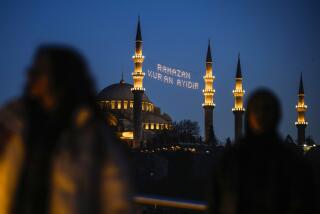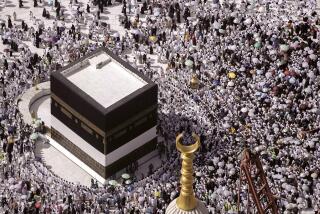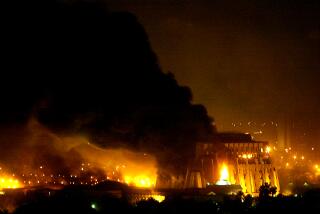A luxury they love to look up to
BAGHDAD -- Standing near glass -- not to mention sitting in a shop brimming with it -- used to be a death wish in bomb-riddled Baghdad. Just ask Muthanna Jabouri, who had to replace the windows of his chandelier shop five times after explosions tore through the street outside.
“The strange thing is, no chandelier was ever damaged,” Jabouri said, sounding awe-struck by his good fortune.
Although the bombs have diminished, Baghdad remains a city where electricity shortages make lavish lighting a luxury, especially the lighting favored by Jabouri’s chandelier-crazy consumers: opulent, ampere-eating fixtures with gold-plated, bulb-laden arms -- the more bulbs, the better to show off the crystal drops and pendants.
But everyone needs some shine in their lives, Jabouri said, explaining his country’s fascination with chandeliers despite the difficulty of keeping them free from Iraq’s ubiquitous dust or glowing when the power suddenly dies.
The shopkeeper has spent time in Britain, and he noticed that people there prefer table lamps and sconces. Not so in Iraq, where it’s hard to get through a day without confronting at least one sparkly chandelier. They’re in mosques, churches, Saddam Hussein’s old palaces, government buildings and private homes. And they’re getting bigger as customers demand fancier creations -- McFixtures, if you will.
“It’s in their nature. Iraqis just like big things,” Jabouri said. “They like to show off what they possess. There might not be any electricity, but they just like to hang it and look at it.”
With the middle class earning more and the country’s violence at its lowest since the U.S.-led invasion of March 2003, business is the best it’s been since before the war, Jabouri said.
“Selling chandeliers is very dependent on the general situation,” said Jabouri, who has had his tiny shop, Al Harith, near the Tigris River for 20 years. “They’re accessories, and people don’t buy them unless they feel comfortable and happy.”
The atmosphere in Al Harith, and in the other chandelier stores lining this stretch of road, could not be more different from the scene outside: Down the street, police and soldiers man a checkpoint marked by grim blast walls. A multistory building lies in a heap at a nearby corner, destroyed in the war and never repaired. Coils of razor wire signal an entrance to the Green Zone a quarter of a mile away.
Passersby can’t help but glance inside Al Harith, at what appears to be a crystal rainstorm.
Jabouri settles visitors into a rich red-and-gray velvet-and-satin love seat and offers them something to drink as they gaze toward the sparkling ceiling. Bulbs glow soft white or mellow amber. Pendants dangle like icicles.
Most of his chandeliers sell for $250 to $300 apiece, though there are exceptions. A massive sparkler in the front window that extends from ceiling to floor goes for $3,500. An even bigger one in the middle of the room, whose 6,556 pieces took three days to interconnect, is $2,500. (It’s cheaper because the lead crystals dripping from the gold-plated chassis are simpler.)
Jabouri, ever the salesman, makes each customer feel special. “We usually sell it for 250,000 dinars [about $215], but for you, 200,000,” he told a man who came in to look at one of the smaller models. After making a sale, he pressed a gift of turquoise-colored glass worry beads into the customer’s hand.
Jabouri doesn’t have any chandeliers himself. They’re too much work, he said, especially the giant ones that lose their luster unless spritzed and buffed regularly.
Where is Iraq’s biggest? That’s debatable. In September, when the outgoing commander of U.S. forces in Iraq, Army Gen. David H. Petraeus, handed power to Army Gen. Ray Odierno in the rotunda of Hussein’s former Al Faw Palace, soldiers and journalists gathered along a marble railing circling the massive chandelier did a little speculating. Some soldiers insisted that the fixture was the largest in the country and the second-largest in the world.
According to a history of the palace provided by the U.S. military, the Al Faw fixture boasts 256 lights.
“People who view the chandelier suspension decide never to walk under it again,” said the document, attributed only to a “military historian.”
That might be wise. A far smaller chandelier, which hung for 48 years over the altar at the Mar Yousif Chaldean church in east Baghdad, crashed to the ground one night in September. Nobody heard it fall, but the next morning, parishioners arriving for the 6:30 Mass found it in pieces, said Sister Warda, the mother superior.
“From 1960 until now, it was just too much,” she said.
A replacement now hangs beneath a sky-blue dome in the church’s cool interior. On a recent afternoon, church staff members cranked up the generator to show the full effect of the chandelier, which is rarely lighted because of electricity shortages. In seconds, the pear-shaped fixture was transformed from a pretty-but-colorless ceiling light into a glowing constellation that drew all eyes to the altar.
Each day, church workers clean its hundreds of crystal drops.
One of Jabouri’s competitors, Haider Majed Hussein, sold the chandelier to the church, as well as a 24,000-piece fixture to the Imam Kadhim shrine in Baghdad’s Kadhimiya district. It took 12 men 10 days to construct that chandelier, which is 26 feet high and 8 feet wide -- slightly bigger than a shipping container.
Throughout the Middle East, mosques and churches are adorned with lavish light fixtures, paid for with endowments from governments or wealthy worshipers. The Sheik Zayed mosque in Abu Dhabi, United Arab Emirates, claims to have the world’s largest chandelier, at 49 feet high and 32 feet wide.
Hussein says he knows the location of Iraq’s biggest because it came from his shop. It hangs in the palace of Iraqi President Jalal Talabani, measures nearly 28 feet high and 13 feet wide and has about 100,000 crystals, Hussein said proudly.
Business plummeted after the U.S.-led invasion, when many wealthy Iraqis closed up their homes and fled the country, Hussein said.
“Our business relies on rich people, not poor,” he said. For a while, Americans were among his customers, coming over from the Green Zone across the street. But they stopped after violence soared.
Like Jabouri, Hussein has never been injured in a blast and never lost a chandelier. However, a large blue glass vase was broken in a bombing, and he keeps it at his store’s entrance as a reminder of how things used to be.
These days, most of the chandeliers he and Jabouri sell are made in China. Regular customers can’t afford the Murano glass or Bohemian crystal pieces made in Europe, and it’s not worth stocking them.
Jabouri says the customers, too, have changed since the war. Much of Iraq’s new moneyed class has no taste and wouldn’t appreciate a fine European-made fixture, he said. He is suspicious of where they get their money, hinting that crime and corruption may be involved.
“It’s hard to explain,” he said. “It’s something about the way they dress, and their language. They always look for the biggest ones, and they like colorful ones. I have to make money, but I hate to sell to these people.”
He has far fonder memories of the customer who arrived at his shop years ago, before the war, along with his family. Too poor to buy anything, the man asked if they could simply stare at the chandeliers and enjoy their glittering magic.
More to Read
Sign up for The Wild
We’ll help you find the best places to hike, bike and run, as well as the perfect silent spots for meditation and yoga.
You may occasionally receive promotional content from the Los Angeles Times.







